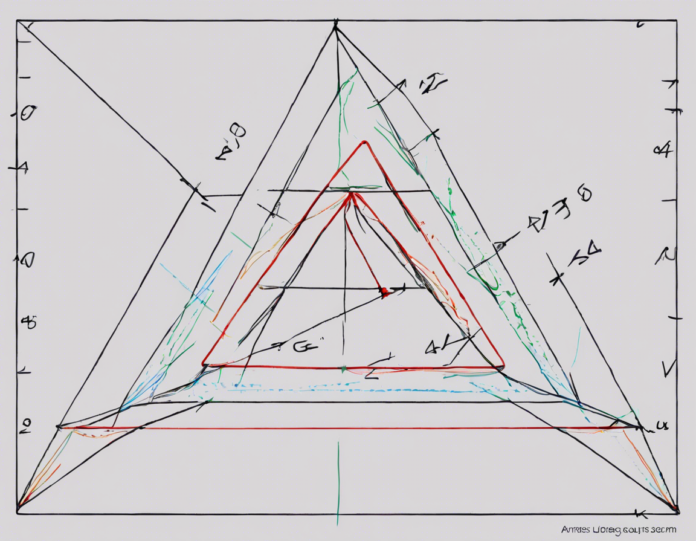Triangles are fundamental geometric shapes that are of immense importance in mathematics, physics, engineering, and various other fields. One of the key elements of a triangle is its vertex. Understanding the concept of a vertex in a triangle is crucial for not only grasping the basics of geometry but also for delving into more advanced topics such as trigonometry, calculus, and even computer graphics.
In this comprehensive guide, we will delve into the vertex of a triangle, exploring its definition, properties, significance, and applications. By the end of this article, you will have a thorough understanding of what a vertex is in the context of a triangle and how it influences different aspects of geometry and beyond.
Definition of a Vertex in a Triangle
In geometry, a triangle is a polygon with three sides and three angles, which are formed at the points where the sides intersect. The point where two sides of a triangle meet is called a vertex (plural: vertices). A triangle has three vertices, and they are usually denoted by capital letters such as A, B, and C.
Types of Vertices in a Triangle
1. Acute Vertex: An acute vertex is one where the interior angle of the triangle formed at that vertex is less than 90 degrees.
2. Obtuse Vertex: An obtuse vertex is one where the interior angle of the triangle formed at that vertex is greater than 90 degrees but less than 180 degrees.
3. Right Vertex: A right vertex is one where the interior angle of the triangle formed at that vertex is exactly 90 degrees.
Properties of Vertices in a Triangle
-
Unique Location: Each vertex in a triangle is located at the intersection of two sides and is a unique point that helps define the shape of the triangle.
-
Sum of Angles: The sum of the interior angles of a triangle at its vertices is always 180 degrees. This fundamental property is known as the Triangle Sum Theorem.
-
Exterior Angles: The exterior angle at each vertex of a triangle is equal to the sum of the two non-adjacent interior angles at that vertex. This is known as the Exterior Angle Theorem.
-
Incenter, Circumcenter, and Centroid: Vertices play a crucial role in defining important points in a triangle such as the incenter (intersection of angle bisectors), circumcenter (intersection of perpendicular bisectors), and centroid (intersection of medians).
Significance of Vertices in Geometry
-
Triangle Classification: The properties of vertices help classify triangles into different types based on angles (acute, obtuse, right) and sides (equilateral, isosceles, scalene).
-
Triangle Construction: Vertices are essential for constructing triangles using specific criteria such as side-side-side (SSS), angle-angle-side (AAS), etc.
-
Triangle Centers: Vertices are instrumental in determining the locations of essential triangle centers such as the orthocenter, centroid, and circumcenter.
-
Angle Measures: Vertices aid in calculating various angles within a triangle, which is crucial for solving geometry problems and real-world applications.
Applications of Vertex in Real Life
-
Architecture: Architects use the concept of vertices in triangles to design stable structures and aesthetically pleasing buildings.
-
Navigation: The understanding of vertices in triangles is vital for navigation systems, map projections, and determining distances between locations.
-
Surveying: Surveyors rely on triangle vertices to accurately measure distances, angles, and elevations of different points on the land.
-
Computer Graphics: Vertex manipulation is a fundamental concept in computer graphics for rendering 3D objects and creating realistic animations.
Frequently Asked Questions (FAQs)
Q1: Why are vertices important in geometry?
A1: Vertices help define the shape and properties of geometric figures, such as triangles, polygons, and polyhedra.
Q2: How many vertices does a triangle have?
A2: A triangle has three vertices.
Q3: Can a triangle have more than one right vertex?
A3: No, by definition, a triangle can have at most one right vertex.
Q4: What is the relationship between the vertices and sides of a triangle?
A4: Vertices are the points where the sides of a triangle intersect, defining its shape and angles.
Q5: In what real-world scenarios are vertices of triangles used?
A5: Vertices of triangles are used in architecture, navigation, surveying, and computer graphics, among other applications.
In conclusion, the concept of vertices in a triangle is a fundamental aspect of geometry and has wide-ranging applications in various fields. By understanding the role of vertices in defining the shape, angles, and properties of triangles, one can appreciate the significance of this geometric element in both theoretical and practical contexts. vertices.

